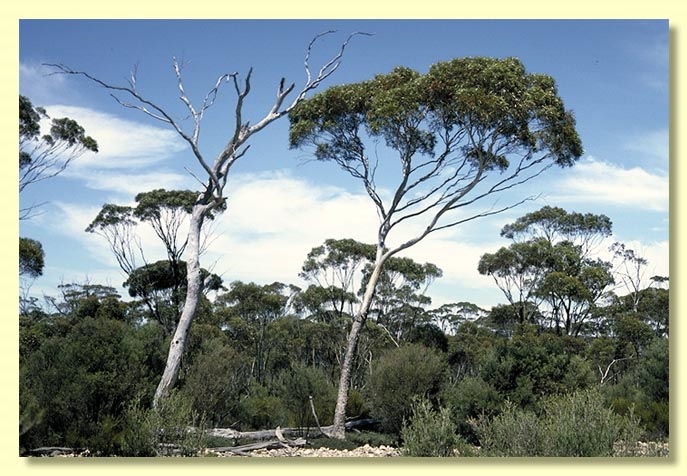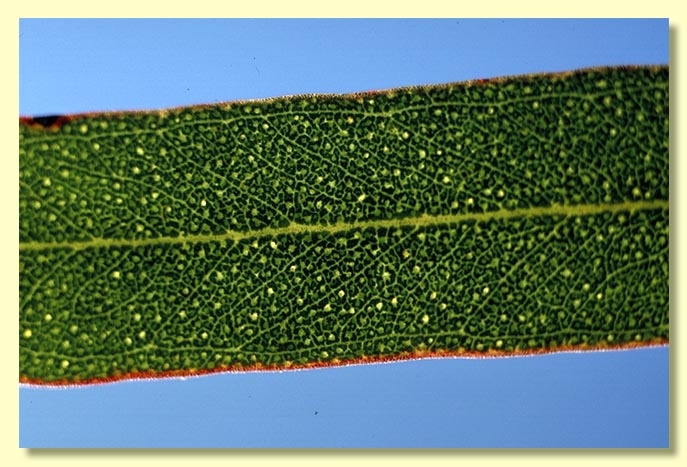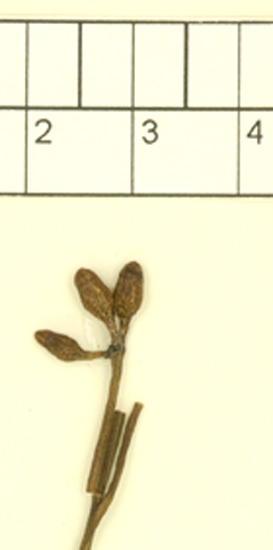Eucalyptus | Symphyomyrtus | Dumaria | Ovulares
Euclid - Online edition
Eucalyptus ovularis
Classification
Nomenclature
Description
Tree to 12 m tall or mallee. Forming a lignotuber.
Bark rough, grey to blackish, flaky, fissured, firm, extending over part of trunk, rarely to large limbs, smooth above, white and greenish to pale grey and pinkish or orange.
Branchlets have oil glands in the pith, although sometimes glands very few.
Juvenile growth (coppice or field seedlings to 50 cm): stems square in cross-section; juvenile leaves always petiolate, opposite for ca 5 nodes then alternate, lanceolate, 6.5–10 cm long, 1.5–2.5 cm wide, dull, grey-green.
Adult leaves alternate, petioles 0.4–1.2 cm long; blade linear to narrowly lanceolate, 6–10 cm long, 0.5–1 cm wide, base tapering to petiole, margin entire, apex finely pointed, glossy, green, side-veins at an acute or wider angle to midrib, reticulation moderate to dense, intramarginal vein close to margin, oil glands intersectional.
Inflorescence axillary unbranched, peduncles 0.7–1.7 cm long, buds 9 to 13, pedicellate, pedicels 0.2–0.4 cm long. Mature buds ovoid to cylindrical (0.45–0.8 cm long, 0.25–0.4 cm wide), usually widest near base of hypanthium, scar present, operculum rounded to conical (0.15–0.3 cm long), stamens inflexed, anthers oblong, versatile, dorsifixed, dehiscing by longitudinal slits, style long and straight, stigma broadly rounded to blunt, locules 3, the placentae each with 4 vertical rows of ovules. Flowers white.
Fruit pedicellate, pedicels 0.2–0.4 cm long, barrel-shaped to slightly urceolate, 0.4–0.6 cm long, 0.4–0.5 cm wide, disc descending vertically, valves 3, enclosed.
Seeds mid-brown, 0.8–1.5 mm long, flattened-ovoid, dorsal surface shallowly but clearly reticulate, hilum ventral.
Cultivated seedlings (measured at ca node 10): cotyledons reniform; stems rounded in cross-section; leaves always shortly petiolate, opposite for 5–7 nodes then alternate, narrowly lanceolate to linear, 3.5–7 cm long, 0.5–2 cm wide, dull, green.
Bark rough, grey to blackish, flaky, fissured, firm, extending over part of trunk, rarely to large limbs, smooth above, white and greenish to pale grey and pinkish or orange.
Branchlets have oil glands in the pith, although sometimes glands very few.
Juvenile growth (coppice or field seedlings to 50 cm): stems square in cross-section; juvenile leaves always petiolate, opposite for ca 5 nodes then alternate, lanceolate, 6.5–10 cm long, 1.5–2.5 cm wide, dull, grey-green.
Adult leaves alternate, petioles 0.4–1.2 cm long; blade linear to narrowly lanceolate, 6–10 cm long, 0.5–1 cm wide, base tapering to petiole, margin entire, apex finely pointed, glossy, green, side-veins at an acute or wider angle to midrib, reticulation moderate to dense, intramarginal vein close to margin, oil glands intersectional.
Inflorescence axillary unbranched, peduncles 0.7–1.7 cm long, buds 9 to 13, pedicellate, pedicels 0.2–0.4 cm long. Mature buds ovoid to cylindrical (0.45–0.8 cm long, 0.25–0.4 cm wide), usually widest near base of hypanthium, scar present, operculum rounded to conical (0.15–0.3 cm long), stamens inflexed, anthers oblong, versatile, dorsifixed, dehiscing by longitudinal slits, style long and straight, stigma broadly rounded to blunt, locules 3, the placentae each with 4 vertical rows of ovules. Flowers white.
Fruit pedicellate, pedicels 0.2–0.4 cm long, barrel-shaped to slightly urceolate, 0.4–0.6 cm long, 0.4–0.5 cm wide, disc descending vertically, valves 3, enclosed.
Seeds mid-brown, 0.8–1.5 mm long, flattened-ovoid, dorsal surface shallowly but clearly reticulate, hilum ventral.
Cultivated seedlings (measured at ca node 10): cotyledons reniform; stems rounded in cross-section; leaves always shortly petiolate, opposite for 5–7 nodes then alternate, narrowly lanceolate to linear, 3.5–7 cm long, 0.5–2 cm wide, dull, green.
Flowering Time
Flowering has been recorded in June and August.
Notes
Eucalyptus ovularis is a tree or mallee of low woodlands on calcareous sandy loams and is endemic to Western Australia. It has a scattered distribution from around Salmon Gums, Grass Patch and near Peak Charles north to Dundas Nature Reserve, near Binyarinyinna Rock, and in the south-east in the vicinity of Mt Ney, Clyde Rock and Junana Rock south of Balladonia.
Eucalyptus ovularis belongs in Eucalyptus subgenus Symphyomyrtus section Dumaria because the buds have two opercula, stamens are strongly inflexed, ovules are in four rows on the placentae and cotyledons are reniform. Within section Dumaria it belongs to a small sub-group of nine closely related species, series Ovulares. The series is further diagnosed by glandular pith, cuboid anthers, and seeds with a brown shallowly and clearly reticulate dorsal seedcoat.
Some of the species in series Ovulares are completely smooth-barked (E. cyclostoma, E. cylindrocarpa, E. exigua and smaller plants of E. oraria) and therefore easily distinguished, while others (E. aequioperta, E. baudiniana, E. comitae-vallis, E. myriadena and E. ovularis) have rough bark over at least part of the stems.
E. ovularis has a rough trunk, glossy green crown and more or less cylindrical buds that are basally dilated unlike any other species in series Ovulares. Within its natural range it is only likely to be confused with E. myriadena, which has smaller, more cylindrical buds and fruits and E. aequioperta, which has small ovoid buds.
Eucalyptus ovularis belongs in Eucalyptus subgenus Symphyomyrtus section Dumaria because the buds have two opercula, stamens are strongly inflexed, ovules are in four rows on the placentae and cotyledons are reniform. Within section Dumaria it belongs to a small sub-group of nine closely related species, series Ovulares. The series is further diagnosed by glandular pith, cuboid anthers, and seeds with a brown shallowly and clearly reticulate dorsal seedcoat.
Some of the species in series Ovulares are completely smooth-barked (E. cyclostoma, E. cylindrocarpa, E. exigua and smaller plants of E. oraria) and therefore easily distinguished, while others (E. aequioperta, E. baudiniana, E. comitae-vallis, E. myriadena and E. ovularis) have rough bark over at least part of the stems.
E. ovularis has a rough trunk, glossy green crown and more or less cylindrical buds that are basally dilated unlike any other species in series Ovulares. Within its natural range it is only likely to be confused with E. myriadena, which has smaller, more cylindrical buds and fruits and E. aequioperta, which has small ovoid buds.
Origin of Name
Eucalyptus ovularis: Latin ovularis, pertaining to an egg, referring to the bud shape.
Copyright © CANBR 2020, all rights reserved.

Web edition hosted at https://apps.lucidcentral.org/euclid















